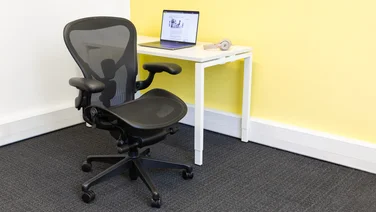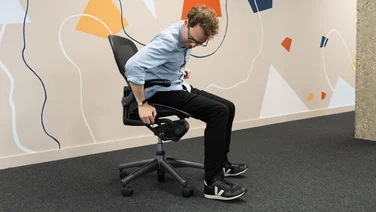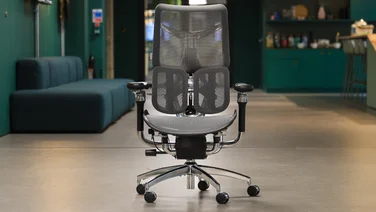To help us provide you with free impartial advice, we may earn a commission if you buy through links on our site. Learn more

In all of the testing and reviewing we do to find the best office chairs, we’ve to delve into the world of kneeling office chairs. To learn more about them, we chatted with Georgette Beacham at storage solution experts BiGDUG, who explained about the benefits and potential drawbacks of using a kneeling office chair. We also spoke to James Mackie, office chair expert at BestBuy Office Chairs, who offered valuable insight into whether or not you should use a kneeling chair.
What are the benefits of a kneeling office chair?
Improves posture – The slight forward tilt of a kneeling chair promotes a natural, open posture: the hips open up and the spine is aligned into a more neutral position, so it’s easier to sit up straight.
Increases circulation – Compared to a traditional chair’s 90-degree seated angle, the open hip angle facilitated by a kneeling chair can alleviate pressure on the blood vessels in your legs, improving blood circulation.Reduces lower back pain – The unique sitting position allows your weight to distribute more evenly through the lower body, reducing strain on the spine and lessening the pressure on hips and buttocks.
Engages core muscles – As there’s no backrest, your core muscles are continually engaged. This promotes “active sitting” (also known as “dynamic sitting”), which improves your upper-body balance, control and stability, and reduces your desire to slouch when tired.
Increased movement – ”Active sitting” helps your body to naturally move a little while seated; side-to-side, forwards and back.
Boosts productivity – The increase in low-level movement helps to provide physiological stimulation. In turn, this increases your attention and energy, allowing your mind to focus better.
READ NEXT: Best office chairs for back pain
Are there any downsides to consider?
Restricted movement – A kneeling chair means the user’s feet will not be on the floor. This can limit leg flexibility during use, as well as restricting your ability to move around freely when reaching for items in your surroundings. As a result, this could lead to circulation issues and potential cramping, as well as straining your knees.

Length of use – It’s recommended to only use most kneeling chairs for a maximum of eight hours at a time. As such, those who need to sit for longer periods of time should consider a different chair.
When should you avoid using a kneeling chair?
Whether kneeling office chairs are good for you or not ultimately depends on your own body. For those with lower back pain, or even hip and pelvic pain, kneeling chairs can be a source of relief as body weight is distributed to the knees and legs, alleviating pressure on the lower back and improving blood circulation in the lower part of your body. However for those with knee, leg or foot pain, they can cause extra discomfort.

If you’re someone who needs support to their upper body, or finds that their shoulders and arms are uncomfortable without a rest, then a kneeling chair might not be the best option.
One of the main problems with kneeling office chairs is the lack of arm and upper-body support. These chairs usually don’t have arm rests, and the upper-body support that they offer won’t be the same as with a standard office chair.
READ NEXT: Best ergonomic office chairs
Is there anything else to consider?
Don’t jump into using it – If you opt to buy a kneeling chair, you should introduce it into your office environment slowly with some light use at first before building up the amount of time you use it. Making a sudden change between sitting and kneeling chairs can cause excessive pressure on your joints, as your body won’t be used to this position and holding your weight in this way.
Is your office space suitable? – It’s vital that your kneeling chair is properly aligned with the rest of your work equipment. If it’s too low or too high for your desk, using one will be counter-productive when it comes to offering you relief.
Has the chair been assessed to a professional standard? – Using a Chiropractor-approved kneeling chair is the best option to put your mind at ease, as this means the chair has undergone rigorous testing by qualified chiropractors.





